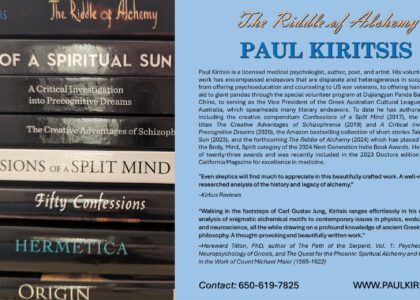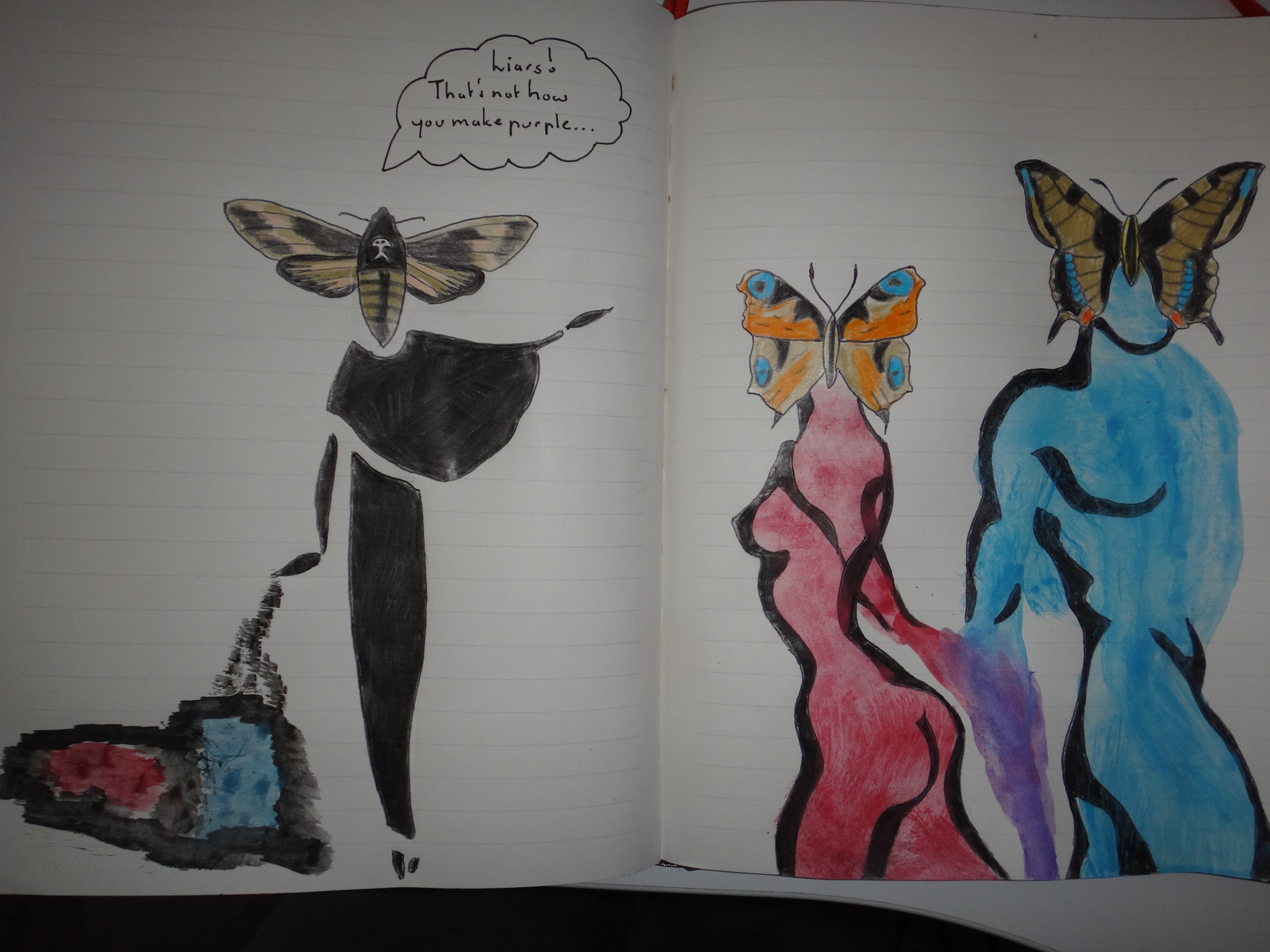
Carl Gustav Jung’s persistence in deciphering the cryptic, convoluted, and exasperating imagery presented in many ancient, medieval and Renaissance alchemical manuscripts was instrumental in eliciting a renewed twentieth century interest in alchemy as a corroborating aspect of depth psychotherapy. In the last few centuries preceding this phenomenon alchemy had fallen into disrepute as a rudimentary protochemistry superseded by the manifold developments of Enlightenment science, a discipline of no practicable use except to the quacks of Victorian occultism who still ambled about in garage laboratories trying to transmute lead into gold and perfecting methods of pseudo-transmutation by which select credulous members of the general public might be duped. Of course these sentiments began to dissipate when Jung pioneered a panpsychic model explicating that the entire alchemical opus was in fact a symbolic anatomical dissection of humankind’s plight for wholeness, the self-actualizing process known as individuation. It was developed on the conviction that the collective consciousness of Western civilization has evolved under the mediation of a monotheistic religion whose dogmatic nature is rudely indifferent to the inner life and to the innate psychic dowry of natural tendencies that make each one of us a distinct and individual personality. With the roots of consciousness estranged from their origin in the unconscious for such a long time the only way the Western soul could express its desire for totality, for reintegration, and for a return to the paradisal perfection that was lost at birth without being apprehended by the Catholic Church was through the veiled language of laboratory processes and chemical reactions.
Before I detail how the unconscious processes of psychological reintegration embody the Hermetic Art and the search for the Philosopher’s Stone some background information on the individual phases of the alchemical opus is necessary. In the Emerald Tablet, perhaps the most important medieval article on alchemy that has thus come to light, the thrice-greatest patron of the esoteric sciences and arts Hermes Trismegistus lays forth thirteen propositions hinting at the notion that alchemical methodology is an individual and world-creating process whereby pure energy is transliterated into imagination and imagination into matter. The alchemist’s job was to achieve unio mystica (mystical union) with the transcendental realm of the divine and understand how these cosmic works of creation could be recapitulated in miniature through normal chemical processes. Looking at the symbolic content of alchemical manuscripts from a historiographical perspective, it becomes obvious that the primary writers rarely expressed unanimous opinions on specific aspects of the alchemical opus. There are variances in opinion on almost every aspect; from the time of the year that the Work should commence and the chronological sequence of stages to the number and type of ingredients and utensils that should be used along with the colour and texture of the final product.
Despite this discordant fact details of practical work were usually spoken of in the context of a three or four colored division that was underpinned by a sevenfold schema; the Saturnine, Jovial and Lunar forces lunarized the base matter by initiating chemical processes such as calcination, solution and putrefaction which brought about nigredo and albedo in the sealed vessel.[1] Successful completion of latter bestowed upon the alchemist the gift of the “white stone”; the power of healing and of transmuting base matter like lead or mercury into silver. Further operations were then carried out by Venusian, Martian and Solar forces which solarized the just formed “white stone” through chemical reduction, sublimation, coagulation and fermentation.[2] These subsequent reactions in the sealed vessel or glass brought about citrinitas and rubedo, culminating in the synthesis of a glittering red powder of significant weight known as the “red stone”; this was the ultima materia or Philosopher’s Stone, with the power to transmute base metals to gold and impart immortality. The creation of the “white stone” under the aegis of the first three planetary powers comprised what alchemists termed the Lesser Work and the creation of the “red stone” under the aegis of the last three the Greater Work. Mercury, a planet-metal that would have comprised the preliminary stage, was never ascribed a definitive position in its own right because it was considered to be the formative force behind the entire alchemical opus.
The panpsychic model of alchemy packaged by Jung in the last three volumes of his collected works–Psychology and Alchemy (1944), Alchemical Studies (1967), and Mysterium Coniunctionis (1970)–and then delivered to the intellectual mainstream by such established historians like Joseph Campbell and Mircea Eliade is basically a patterned application of his own established theories of the collective unconscious, projection of archetypal contents, and individuation onto cosmological premises put forth by the occult system of alchemical knowledge. By identifying close parallels between enigmatic images of dragons, creatures of classical mythological lore, copulating couples, planetary deities, natural elements, and royal personages to be found in alchemical manuscripts and similar ones rife in the archetypal dreams, hallucinations and visions of his psychotic patients, Jung realized that the elaborate processes and substances being described by the alchemists weren’t tailored towards a material enterprise seeking a rubicund chemical but were in fact emblematic stand-ins for archetypal content psychologically projected onto laboratory apparatuses from the confines of the collective unconscious. Given that psychospiritual development through the self-actualizing process of individuation is typically ahistorical and happens quite unconsciously, there was no way that the alchemists could have known that their hitherto repressed inner lives were becoming exteriorized and attaining hallucinatory realism and authenticity. Basically what Jung is telling us is that the alchemists were engaging in ‘active imagination’, taking bits of fantasy, dream material, or particular feelings and moods and ruminating upon these until they took on a life of their own and evolved into action. Hence the lack of a consensus when it came to alchemical methodology and the exact nature of the prime substance (prima materia) needing to be worked on can be attributed to psychological inimitability. The tabula rasa of each mind is filled with different possessing transpersonal energies and mental states and ‘carries the projection of the autonomous psychic content’ so it makes sense that no two base ‘chemical substances’ (mental states) will ever be identical.
Transposed to the psychological level alchemy becomes something of a generic framework through which Jungian individuation can be comprehended and quantified. A significant quality brought to our attention by the alchemical stages themselves (i.e. necrosis-nigredo, cauda pavonis, leucosis-albedo, xanthosis-citrinitas, and iosis-rubedo) is that self-actualization occurs within the cycle of time whilst at the same time drawing upon disembodied transpersonal energies (i.e. love, desire, envy, passion, greed, hate) that stand without and make transformation possible. One of the first propositions of Hermes’s Emerald Tablet reveals that the prima materia is created out of the fourfold elements–fire, air, water, and earth. Psychologically, these can be understood as the mental faculties of thinking, intuition, feeling, and sensation that differentiate from the collective unconscious to form the personal ego. The lead, salt, mercury, earth, or some other base substance needing to be subjected to the cycles of distillation, concoction, or maceration detailed in alchemical manuscripts is the archetypal situation of the ego personality; the planet-metal stages and tricolour scheme of the opus are the transpersonal energies disconnected from ego consciousness and seeking reintegration; and the end product of gold or the “red stone” is the individuated Self that has reconciled personal and transpersonal factors and thus garnered major increments of consciousness.
So in ascending to the mount of modern depth psychology as it exists today and looking down towards the jutting slopes of the Jungian school; the lesser and more subtle ones of Jocelyn Chaplin; and the fertile investigations of Micheline Boivan, Augustine Meier, and Jungian Edward Edinger into the processes of counselling and psychotherapy we see that the transformative endeavour of self-actualization as outlined by the alchemical opus is cyclical in nature. The expunging of neurotic and behavioural patterns detrimental to the evolution of character may take days, weeks, months, or even years to complete, depending on how deeply entrenched the habits’ roots are in the humus of the collective unconscious. Some persons undergoing therapy require gradual progression through successive cycles and a repetition of various phases to attain freedom from their detrimental mentation and behaviours whilst others only need one. Depending on the temperamental composition of the individual in counselling and the nature of his or her psychological disturbance, a therapist may sidestep, subvert or invert a specific step or a whole assemblage of steps. There are no fixed rules or premeditated techniques and exercises when it comes to healing the ailing psyche. To find resolution and closure an individual may combine a particular configuration of therapeutic methods belonging to different psychological schools of personal development, counsellors, and discarnate spiritual entities. By and large the order of alchemical operations takes a back seat to the random path most able to stimulate psychospiritual transformation, psychic equilibrium, and a realignment of fundamental harmony with the outer world in the one being counselled.
According to the alchemical path, there are three core virtues that must not be forsaken for therapy to be successful. They are perseverance, valour, and a conscious willpower resolute in its ability to subsist through tumultuous and unpredictable mood swings. The deep nature of the individual psyche is rendered comprehensible and it’s deep ‘waters’ become navigable only when the mediating conscious is imbued by such a sulphurous attitude. You must become hotter than fire to evade dissolution wrought by the black embers of pain, trauma, and suffering and worse still, the lamentable fate of actually becoming these embers. If you successfully resist the friction, the struggle, and the premature dissolution brought on by transpersonal energies, an inner fusion of natural tendencies occurs and you develop a ‘superior personality’ able to disengage from and transcend the unbearable gravity of neurotic habits and problems. One alchemical manuscripts says, “O all ye seekers after this Art, ye can reach no useful result without a patient, laborious and solicitous soul, persevering courage, and continuous regimen.” What this means is that maintaining inner calm, patience, and resilience in the face of adversity allows one to navigate through psychological disturbances without running onto a reef of complexes and persistent sticking points.
As the psychotherapeutic process gradually shovels away more and more neurotic dirt from the concretized bundle of psychological impulses to reveal the superior personality hidden within, we begin to see that the tendency to individuation is spurred by unconscious willpower proliferating from the Self. In this scenario of self-actualization ego function plays only a minimal and supporting role (if that). Whether you flower spiritually and become all you were meant to be is pretty much contingent on the willingness of your personal ego to channel and accommodate transpersonal energies compatible with your centre of gravity. Successful collaborations that steer clear of psychic inflation yield more and more consciousness; they create ‘diamond bodies’, gold, and other everlasting gems highly resistant to pressurized forces perceived to manifest from intercourse with the phenomenal world. Therapy enters into this far-ranging picture as a facilitator, ensuring that these natural urges for self-actualization come to pass at an accelerated rate.








